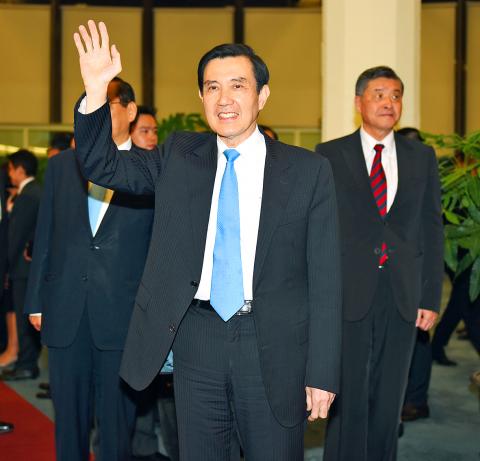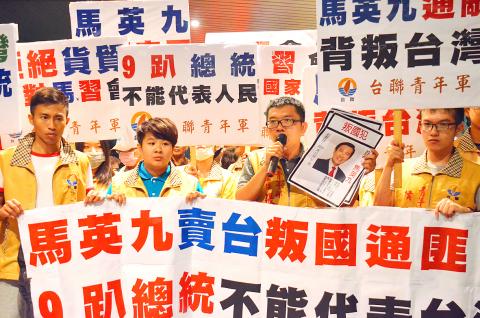In response to criticism over his meeting in Singapore with Chinese President Xi Jinping (習近平), President Ma Ying-jeou (馬英九) defended his performance while on board a flight back to Taiwan, which arrived at Taiwan Taoyuan International Airport early yesterday morning.
During the flight, Ma told reporters that the most significant result of his meeting with Xi was that leaders from the two sides of the Taiwan Strait had finally met and expressed their willingness to jointly discuss relevant issues.
“There are too many problems across the Strait that need to be dealt with. While a number of them have been resolved over the past few years, there are still many left, which is why we require a communication platform at a higher level,” Ma said, adding that the meeting was just a first step.

Photo: CNA
Asked how he felt about Xi’s response to Taiwanese concern over the threat China’s military poses to Taiwan, Ma said he was “not very satisfied” with Xi’s answer that the deployments did not target Taiwan.
“I told Xi that Taiwanese are rather concerned about the issue and hope China could make some gestures of goodwill... While I am not content with Xi’s response, at least I started the dialogue and I will bring up the matter again if given the opportunity in the future,” Ma said.
Ma added that he said everything he “was supposed to say” in front of Xi, including two mentions of the Republic of China (ROC) Constitution, as well as one mention each of the ROC and “one China, different interpretations.”

Photo: Chiu I-tung, Liberty Times
However, Xi did not make any significant reactions to his references to the ROC, Ma said, adding that he did not say “ROC president” during their meeting.
Shrugging off Democratic Progressive Party (DPP) presidential candidate Tsai Ing-wen’s (蔡英文) criticism of the meeting’s outcome, Ma said he had clearly mentioned “one China, different interpretations” and the so-called “1992 consensus” — a term former Mainland Affairs Council chairman Su Chi (蘇起) admitted making up in 2000 that refers to a tacit understanding between the Chinese Nationalist Party (KMT) and the Chinese government that both sides acknowledge there is “one China,” with each side having its own interpretation of what “China” means.
“‘One China, different interpretations’ means we can have different interpretations of the term ‘one China,’ while the ‘1992 consensus’ allows both sides to verbally state their respective interpretations of what ‘one China’ means,” Ma said.
“This is what gives us room [to maneuver]. Without this space, why would it be called the ‘1992 consensus?’” he added.
In regards to his performance at the meeting, Ma said he fulfilled nearly all of his original objectives, including bringing up the “1992 consensus”; “one China, different interpretations”; and the Constitution’s prohibition on remarks such as “two Chinas,” “one China, one Taiwan” and Taiwanese independence.
“Some have misunderstood my words as an attempt to fawn to the People’s Republic of China, but it was not. These terms are forbidden by our own Constitution,” Ma said.
Meanwhile, Premier Mao Chi-kuo (毛治國) said the Ma-Xi meeting had major historic significance, as both leaders took an important first step toward more institutionalized meetings in the future. Mao made the remarks yesterday afternoon while visiting the Taipei International Travel Fair, at which he met with travel industry representatives.
“This historic event has drawn global attention, and we, the people in Taiwan, should be united to tell the world about the importance of having peaceful cross-strait relations,” Mao said. “This is also an opportunity to let the world know about the contributions made by Taiwanese to peaceful development in the Asia-Pacific region.”
When asked if Chinese tourists would be allowed to make transit stops in Taiwan while he remains in office, Mao said that is “one of the follow-up issues that we will have to work on.”

Auckland rang in 2026 with a downtown fireworks display launched from New Zealand’s tallest structure, Sky Tower, making it the first major city to greet the new year at a celebration dampened by rain, while crowds in Taipei braved the elements to watch Taipei 101’s display. South Pacific countries are the first to bid farewell to 2025. Clocks struck midnight in Auckland, with a population of 1.7 million, 18 hours before the famous ball was to drop in New York’s Times Square. The five-minute display involved 3,500 fireworks launched from the 240m Sky Tower. Smaller community events were canceled across New Zealand’s

The Ministry of Foreign Affairs (MOFA) yesterday said it is closely monitoring developments in Venezuela, and would continue to cooperate with democratic allies and work together for regional and global security, stability, and prosperity. The remarks came after the US on Saturday launched a series of airstrikes in Venezuela and kidnapped Venezuelan President Nicolas Maduro, who was later flown to New York along with his wife. The pair face US charges related to drug trafficking and alleged cooperation with gangs designated as terrorist organizations. Maduro has denied the allegations. The ministry said that it is closely monitoring the political and economic situation

‘SLICING METHOD’: In the event of a blockade, the China Coast Guard would intercept Taiwanese ships while its navy would seek to deter foreign intervention China’s military drills around Taiwan this week signaled potential strategies to cut the nation off from energy supplies and foreign military assistance, a US think tank report said. The Chinese People’s Liberation Army (PLA) conducted what it called “Justice Mission 2025” exercises from Monday to Tuesday in five maritime zones and airspace around Taiwan, calling them a warning to “Taiwanese independence” forces. In a report released on Wednesday, the Institute for the Study of War said the exercises effectively simulated blocking shipping routes to major port cities, including Kaohsiung, Keelung and Hualien. Taiwan would be highly vulnerable under such a blockade, because it

UNRELENTING: China attempted cyberattacks on Taiwan’s critical infrastructure 2.63 million times per day last year, up from 1.23 million in 2023, the NSB said China’s cyberarmy has long engaged in cyberattacks against Taiwan’s critical infrastructure, employing diverse and evolving tactics, the National Security Bureau (NSB) said yesterday, adding that cyberattacks on critical energy infrastructure last year increased 10-fold compared with the previous year. The NSB yesterday released a report titled Analysis on China’s Cyber Threats to Taiwan’s Critical Infrastructure in 2025, outlining the number of cyberattacks, major tactics and hacker groups. Taiwan’s national intelligence community identified a large number of cybersecurity incidents last year, the bureau said in a statement. China’s cyberarmy last year launched an average of 2.63 million intrusion attempts per day targeting Taiwan’s critical